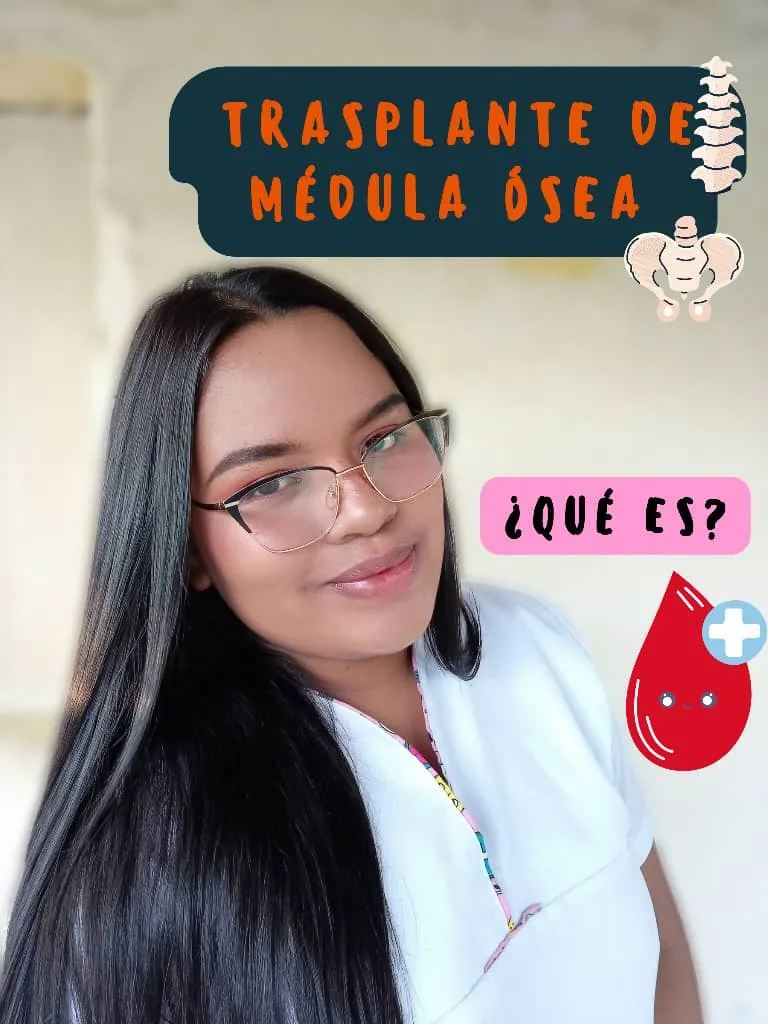
La medula ósea es el tejido esponjoso presente en los huesos que a su vez se encargan de la produccion de celulas sanguíneas, en ella se generan los eritrocitos, leucocitos, trombocitos, cada una de las celulas sanguíneas cumple una funcion importante en el cuerpo, entre ellas el transporte de oxigeno, participan en la respuesta inmune, e intervienen en el proceso de coagulación, cuando la medula osea es afectada no es capaz de formar celulas sanguíneas sanas, existen diferentes enfermedades hematológicas e inmunodeficiencias que requieren el reemplazo de medula osea.

Fotografía editada en @Canva. - Edited photo on @Canva.
Las principales enfermedades que requieren de trasplante de medula osea son: los linfomas de hodgkin y no hodgkin, leucemia, neuroblastoma, anemia aplásica, mieloma múltiple, entre otras, en estos casos el paciente requiere de un trasplante de medula osea para asi eliminar las celulas cancerosas y pueda restablecer la produccion de celulas sanas, por otra parte el tratamiento se complementa con la quimioterapia y radioterapia.

El trasplante de medula osea puede ser tanto extraído desde la misma medula osea del paciente el cual se denomina trasplante autólogo, basicamente no seria como tal un trasplante debido que a la restauración de la medula osea se realiza al extraer las propias celulas madre sanas que quedan en el paciente, por otra parte el trasplante alogénico proviene de otra persona que sea compatible.

Para comprobar la compatibilidad del donador con el paciente primero se debe realizar un estudio del antígeno leucocitario humano, a traves de un análisis de sangre a ambos, cabe destacar que los familiares mas cercanos como los hermanos tambien están en las posibilidades de ser compatibles, tanto al donador como el paciente requieren de una valoración completa por el medico junto a otros análisis de laboratorio.

El procedimiento de la transfusión de celulas madres es bastante parecida a una transfusión sanguinea comun, el paciente podria llegar a presentar algunas reacciones como hipotension, fiebre, disnea estas reacciones adversas se pueden controlar rápidamente ya que la mayoria son leves.

Entre las principales complicaciones que se pueden presentar son: enfermedad de injerto contra el huésped que en la mayoria de los casos suelen producirse posterior al trasplante, enfermedad venooclusiva hepática, en un caso mas grave el cancer podria reaparecer, ocasionar daños en otros organos sin embargo esto va relacionado con el tratamiento como quimioterapias y otros farmacos que pueden afectar a los mismos, el paciente posterior al trasplante durante las primeras semanas se requiere de muchos cuidados en el hogar, principalmente evitar salir demasiado a la calle, evitar las visitas en el hogar dado que el riesgo de contraer infecciones es alto, utilizar cubre bocas, ademas de llevar a cabo el control con su medico.

ENGLISH
The bone marrow is the spongy tissue present in the bones that in turn are responsible for the production of blood cells, in it erythrocytes, leukocytes, thrombocytes are generated, each of the blood cells fulfills an important function in the body, among they transport oxygen, participate in the immune response, and intervene in the coagulation process, when the bone marrow is affected it is not capable of forming healthy blood cells, there are different hematological diseases and immunodeficiencies that require bone marrow replacement.
The main diseases that require a bone marrow transplant are: Hodgkin's and non-Hodgkin's lymphomas, leukemia, neuroblastoma, aplastic anemia, multiple myeloma, among others. In these cases, the patient requires a bone marrow transplant to eliminate the cells. cancerous and can restore the production of healthy cells, on the other hand the treatment is complemented with chemotherapy and radiotherapy.
The bone marrow transplant can be both extracted from the patient's own bone marrow which is called autologous transplant, basically it would not be a transplant as such because the restoration of the bone marrow is carried out by extracting the healthy stem cells that remain in the patient, on the other hand, the allogeneic transplant comes from another person who is compatible.
To check the compatibility of the donor with the patient, a study of the human leukocyte antigen must first be carried out, through a blood test for both, it should be noted that the closest relatives such as siblings are also likely to be compatible, both Both the donor and the patient require a complete assessment by the doctor along with other laboratory tests.
The stem cell transfusion procedure is quite similar to a common blood transfusion, the patient could present some reactions such as hypotension, fever, dyspnea, these adverse reactions can be controlled quickly since most are mild.
Among the main complications that can occur are: graft-versus-host disease that in most cases usually occurs after transplantation, hepatic veno-occlusive disease, in a more serious case the cancer could reappear, cause damage to other organs however this is related to the treatment such as chemotherapies and other drugs that can affect them, during the first weeks the post-transplant patient requires a lot of care at home, mainly avoiding going out too much, avoiding visits at home Since the risk of contracting infections is high, use mouth covers, in addition to carrying out the control with your doctor.

La información que acabas de leer es de mi aprendizaje en la carrera de T.S.U en enfermería. - The information you just read is from my learning in the career of T.S.U in nursing.
El separador e imágenes son de mi propiedad. - The separator and images are my property.
Traducción de: Google traductor - Translation of: Google translator.


Diseño creado en @PicsArt. - Design created in @PicsArt.
